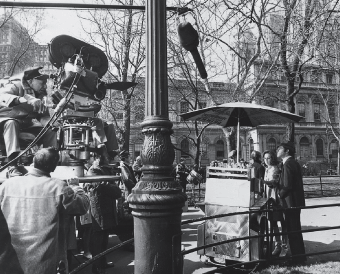Movies and Film: Tracking the History of Camera Movement
Tracking the History of Camera Movement
The camera has not always moved the same way in all film eras. Conventions, technologies, and audience expectations change from decade to decade, and sometimes from year to year.
The Primitive Era
In one sense the camera moved very early in the history of cinematography even while seeming very still. It could be made to move to catch the light of the sun. This was the idea behind the Black Maria, the moveable shooting stage Edison used to keep daylight as long as possible.
For the most part, however, the earliest filmmakers made film with a largely stationary camera. Despite the fact that some of the most important photographic moments leading up to the invention of moving pictures—the Eadward Muybridge motion experiments and the Edward Marey camera "gun"—were all about the movement of birds, horses, the human body, the early moving picture cameras were stationary because it was thought by early moviemakers that a moving camera would only confuse spectators (much the same way that the early filmmakers thought that editing would be confusing to audiences.)
Director's Cut
For some very early filmmakers like Georges Mlis, a fixed camera was absolutely necessary to accomplish early trick photography that confused and amazed audiences. The camera was set to go in front of an actor, and then stopped. The actor was taken out of the scene and the camera began cranking again, creating the illusion that the actor had just "vanished" from the scene.
As well as being concerned about confusing the audience, early cinematographers wanted to keep the camera fixed in a particular place to make the audience feel privileged. The camera was stationed several feet away from the action, in a perpetual medium shot, in order to give all members of the audience the illusion that they had a front-row center seat at the theater. Though containing some interesting examples of editing, the silent Sarah Bernhardt vehicle—Queen Elizabeth (Les Amours de la reine lisabeth, France, 1912)—is quite without camera movement, putting the spectator front-row center.
Further, the technology was so tricky that moving the camera could be rather cumbersome. (Because Edison was wedded to the idea of a motorized camera, his equipment was not as mobile as the hand-cranked cameras of the silent era.) It is also generally more expensive to move the camera both because it takes more time to plan moving shots, and because movement often requires its own technology: Steadicam equipment, tracks, helicopters, airplanes, trucks, and so on.

Shot of camera, crane, and boom microphone in exterior location for Sweet November (1968).
However, cameramen eventually became more adventurous. Cranes and dollies were widely used by the 1920s, and the steadicam became a standard item by the 1960s (enabling, for example, the Vietnam War photography that brought the sounds and movements of the war into the living rooms of middle America for the first time). The camera became progressively more mobile as each decade passed, so that even standard Hollywood light urban comedy could easily contain exterior shots. (A slight hiccup interrupted this mobility when early sound equipment made the camera stationary once more in the late 1920s.)
The continued evolution of film technologies offers at present digital and special effects that enable illusions of camera movements not previously possible: being able, for example, to fall to one's death from atop a skyscraper in The Hudsucker Proxy (1994) or, with 3-D modeling, to navigate in virtual spaces like the computer CPU in Tron (1982).
Director's Cut
A high point in camera movement occurred late in the golden era of Hollywood filmmaking when, in the late 1940s and early 1950s, the camera was so mobile that it actually danced with the musical stars of that era. Look for example at Singin' in the Rain's (1952) two musical numbers "You are My Lucky Star" and "Would You." In the first, the camera performs a sort of pas de trois with Debbie Reynolds and Gene Kelly, while in the second it waltzes lyrically in time with the music. With the introduction of the Steadicam and its location-shooting aesthetic, such lyricism would rarely appear again for several decades.

Excerpted from The Complete Idiot's Guide to Movies and Film © 2001 by Mark Winokur and Bruce Holsinger. All rights reserved including the right of reproduction in whole or in part in any form. Used by arrangement with Alpha Books, a member of Penguin Group (USA) Inc.
To order the e-book book direct from the publisher, visit the Penguin USA website. You can also purchase this book at Amazon.com.
